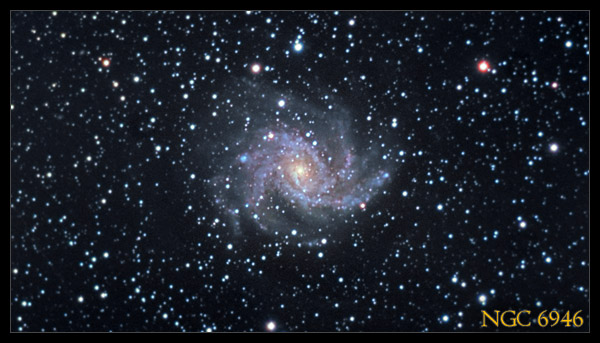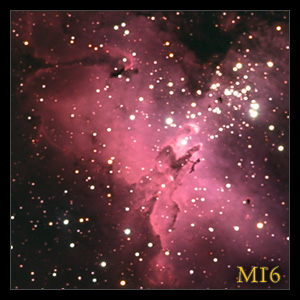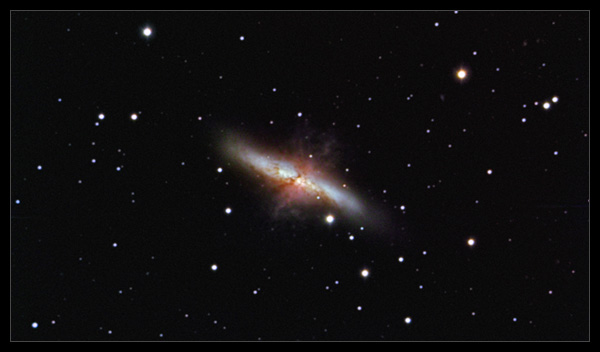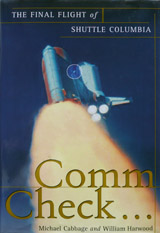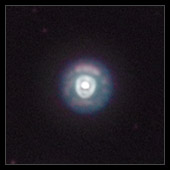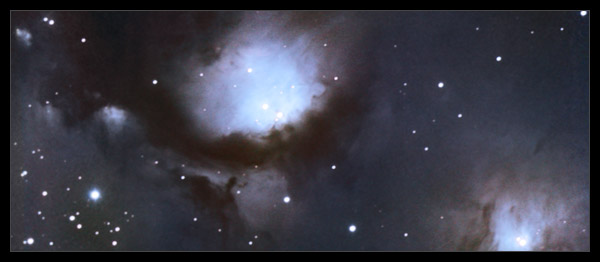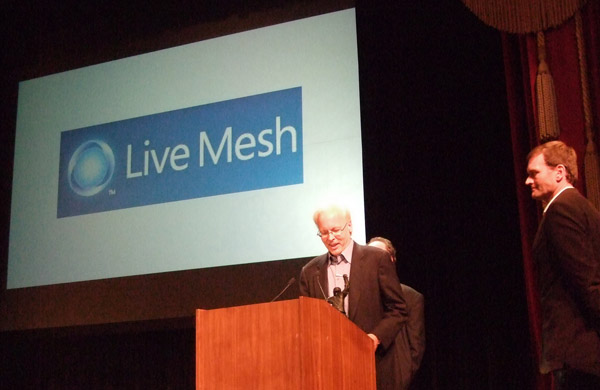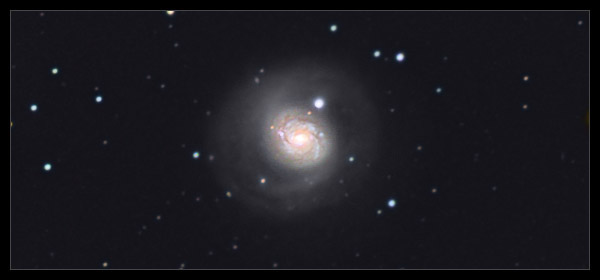
2009 Archives
NGC 6946 |
1 September 2009 |
|
The galaxies of Autumn are starting to appear. |
|
M16 |
30 June 2009 |
I don't remember where I first saw that image, but I remember thinking how beautiful and amazing it looked. For the first time I could imagine this distant nebula as a real place. Now I've finally captured that nebula with my own modest equipment. While it does not compare to Hubble's iconic image, it does connect me, in some small way, to that magnificent object. |
|
Clear Skies Are not Steady Skies |
20 June 2009 |
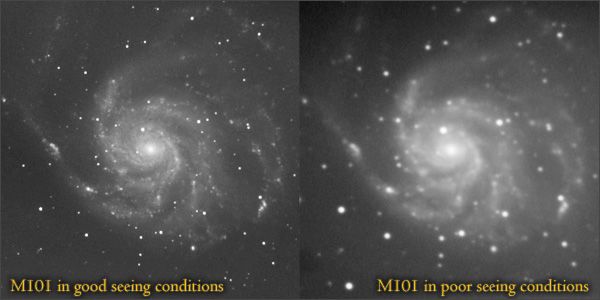
Just because the skies are clear doesn't mean that it will be a good night for astrophotography. Sometimes the skies are turbulent because of winds or temperature changes. On those nights the stars will twinkle ferociously and looking at the sky through a telescope will be like looking at the bottom of a clear lake on a windy day. Astronomers call that "bad seeing" and it causes the light from distant stars to flicker and jump. Needless to say this distorts astronomical images, leaving them blurry and wavy. The image on the left is a shot of the galaxy M101 under good seeing conditions. The one on the right shows the same galaxy, taken with the same equipment, on a night of poor seeing. |
|
Astrophotography Targets for April |
8 April 2009 |
||||||||||||||||||||||||||||||||||||||||||||||||||||||||||||||||||||||||||||||||||||||||||||||||||||||||||||
The most popular target in April is the Leo triplet, a grouping of three beautiful spirals: M65, M66, and NGC 3628, but there are other, less famous, galaxies this month that are well worth capturing. |
|||||||||||||||||||||||||||||||||||||||||||||||||||||||||||||||||||||||||||||||||||||||||||||||||||||||||||||
M82 |
30 March 2009 |
|
Unravelling the nature of M82 took almost two centuries and required dozens of independent insights from many astronomers. But Johann Bode, the one who first spotted those two faint patches of light and wrote them down in his journal, is the only name commonly associated with M81 and M82. Those other astronomers? I confess I don't even know their names. |
|
Comm Check |
13 March 2009 |
|
February 1, 2003. It’s a little before 9 AM and in 20 minutes the Space Shuttle Columbia is scheduled to land in Florida. In Mission Control, mechanical systems officer Jeff Kling notices two sensors on Columbia’s left wing have cut out. A few moments later, two more cut out. He discusses it with flight director LeRoy Cain, but neither can explain the event. How could four independent sensors just suddenly stop working? But then Cain remembers back to Columbia’s launch and the large chunk of foam that hit the shuttle as it was rocketing up at supersonic speeds. The debris had hit Columbia’s left wing. Could the loss of the sensors be related? It couldn’t be, thinks Cain. It has to be a coincidence. |
|
Astrophotography Targets for March |
4 March 2009 |
||||||||||||||||||||||||||||||||||||||||||||||||||||||||||||
March is the beginning of galaxy season! In its trek around the sun the Earth's nightside sometimes faces the disk of our galaxy. When that happens we see the band of the Milky Way high above us. But as the Milky Way dips towards the horizon, we see what lies beyond our little metropolis of stars—and that means galaxies of all kinds.
Read more... |
|||||||||||||||||||||||||||||||||||||||||||||||||||||||||||||
Infinite Lives: Experience Transcendence |
3 March 2009 |
|
"The best part is when you play for long enough, get into the hypno-zone that lets you X-ray-view straight through the sci-fi surface and down into pure, universal mechanics: when you look at a “stargate” and see a “dungeon stairway,” a “ROM upgrade” and see a “magic scroll,” a “barrel labelled NOT FOR HUMAN CONSUMPTION” and see a “potion,” you’re seeing through the illusion, not “suspending disbelief” but building up disbelief to such a degree that you’re not just playing a game, you’re playing all games" |
|
The Eskimo Nebula |
8 February 2009 |
Fortunately, only a few weeks later, a Space Shuttle orbiter rendezvoused with Hubble and four astronauts repaired the multi-billion dollar telescope in a series of spacewalks. To test out the newly repaired observatory, scientists on Earth commanded it to point to a target and take some pictures. The result was magnificent—the telescope had been fully repaired. And the target that Hubble captured, a bright planetary nebula known as the Eskimo Nebula, was revealed in all its glory. My shot of the Eskimo Nebula (or NGC 2392) is of course far inferior to Hubble's. Nevertheless, there is something very satisfying in capturing the same object. You don't need a ten billion dollar space program to enjoy the night sky. All you need is some modest equipment, a little luck, and a lot of patience. |
|
Astrophotography Targets for February |
1 February 2009 |
||||||||||||||||||||||||||||||||||||||||||||||||||||||||||||||||||||||||||||||
Astronomers love catalogs the way physicists love graph paper and biologists love gooey biological stuff. When I bought my first CCD camera, I didn't need a catalog: My target choices were either the Orion Nebula or the Whirlpool Galaxy. Everything else looked like a brownish blob of varying texture and fuzziness. Now that cameras (and my skills) have improved, I have more choices. Every month I pore through my catalogs in search of interesting objects that might make good pictures. Last month I wrote down my favorite objects for January. This month I list my favorite objects between 6 and 8 hours of Right Ascension, that is, those objects that happen to be pretty high in the sky at night in February:
|
|||||||||||||||||||||||||||||||||||||||||||||||||||||||||||||||||||||||||||||||
M78 |
23 January 2009 |
|
M78 was harder to capture than I expected. The faint nebulae and dark clouds required a lot of exposure time and some aggressive processing. |
|
Big Download Reviews Transcendence |
11 January 2009 |
||
|
|||
Live Mesh Wins 2008 Crunchie |
10 January 2009 |
|
Winning isn't everything, but it's nice when it happens. Live Mesh won the 2008 Crunchie award for Best Technological Innovation or Achievement. We were up against Google Chrome (which I thought was going to win) and Facebook Connect (which got second place). The list of companies and products that were nominated for Crunchie awards reads like a who's who of trendy, cool start ups and products. It's a world that Microsoft doesn't often appear in (our business enterprise competitors, IBM and Oracle, for example are nowhere near it). |
|
M77 |
9 January 2009 |
|
M77 has been badly neglected photographically, at least compared to more popular galaxies like M51 and NGC 891. The Hubble Space Telescope hasn't imaged the whole thing yet, though both Robert Gendler and Russell Croman have (which is almost as good). One reason for skipping M77 is that it is very difficult to capture. The long exposures required to bring out its faint outer arms often leave its bright central core overexposed. Nevertheless, the results are worth it. I love its tightly wound disk and the contrast with its faint outer arms. It looks a lot like M94, which is another favorite of mine. |
|
Astrophotography Targets for January |
1 January 2009 |
||||||||||||||||||||||||||||||||||||||||||||||||||||||||||||||||||||||||||||||||||||||||||
With the beginning of the New Year we say goodbye to the galaxies of Andromeda and say hello to the nebulae of Orion. January is the best month to capture the Orion Nebula, the most famous nebula in the sky and probably the easiest deep space object to photograph. But there are many other nebulous objects to capture this month. These are some of my favorites:
|
|||||||||||||||||||||||||||||||||||||||||||||||||||||||||||||||||||||||||||||||||||||||||||
